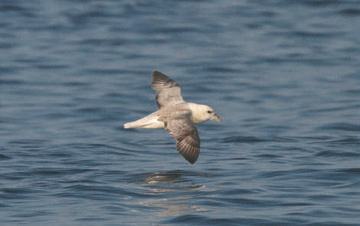Fulmar (Fulmarus glacialis)

Fulmar © Jeff Clarke
Most Fulmars pass our coast in the period March to October, and winter records are unusual. Birds were reported in three tetrads for this Atlas, all in winter 2006/ 07: Hilbre (SJ18Z), Hoylake shore (SJ28E) and off Leasowe (SJ29R).
Coward and Oldham (1900) knew of no winter records, and Bell (1962) could trace only two, both inland: on the River Mersey at Ince, 21 November 1908 and at Witton flashes 29 January 1929. The next on record is in the county bird report for 1971, on 24 January, followed by singles in 1973, 1974, 1975 and 1977, three in 1979 and five in 1982, then ‘throughout the year’ in 1982, after which records become jumbled although they were not present in every winter. More recently, in the ten years from 1996/ 97 to 2005/ 06, Fulmars were recorded in six of those winters but not the others. These ten years yielded a total of only ten winter records, all in January and February apart from one on 28 December 1997; seven were off Hilbre, two off Hoylake and one over West Kirby town centre.
The origins of the birds seen off the Wirral coast are not known. After fledging in September, young Fulmars spend perhaps four years at sea, dispersing widely (some as far as the fishing grounds off Canada and Greenland) and probably never visiting land. They then spend five or more years visiting colonies until, at about nine or ten years of age, they are ready to breed. Adults occupy their nest sites throughout the year, and all but one of the ringed birds from Scottish colonies found in the Irish Sea outside the breeding season have been immatures (Migration Atlas), suggesting that the Wirral birds will be sub-adults. However, breeding birds will forage for several hundred kilometres from their nest, and this is thought to apply in winter as well (BTO Winter Atlas), so adults from the colonies on cliffs along the north Wales coast, in Cumbria and the Isle of Man could well visit this area.

